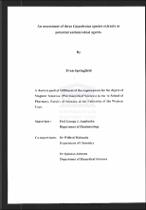An assessment of three Carpobrotus species extracts as potential antimicrobial agents.
Abstract
For centuries, indigenous people in South Africa have used a variety of medicinal herbs to treat chronic infections. This investigation focused on three Carpobrotus species, in an attempt to assess their potential antimicrobial activity. Extracts of varying polarities of the plants were prepared and tested against Staphylococcus aureus, Pseudomonas aeruginosa, Candida albicans and Mycobacterium smegmatis. For the disc diffusion method Ciprofloxacin (4Opg/disc) served as positive control for ^S. aureus, P. aeruginosa and M. smegmatis, whereas amphotericin B (25 pg/disc) was the control for C. albicans. A sample concentration of 10mg/ml was used. Minimum inhibitory concentrations (MIC) were determined by two-fold serial dilution. Phytochemical analysis was completed to test for the presence of flavanoids, hydrolysable
tannins, phytosterols and aromatic acids. The ethyl acetate extracts {2lpl of 95mg/ml) were used for bio-autography, together with TLC analyses and HPLC fingerprinting. Carpobrotus mellei, Carpobrotus muirrii and Carpobrotus quidrifidus showed antimicrobial activity against S. aureus and M. smegmatis in the disc diffusion method and inhibition against S. aureus and M.smegmatis was observed by clear zones on the TLC plate. HPLC fingerprinting of the three species showed similarities with common peaks detected at 366 nmi, and providing a
phytochemical map of potentially important natural bioactives. This investigation confirms that extracts of the three Carpobrotus species that are used as indigenous medicines, exhibits anti-bacterial activity. This scientific information can serye as an important platform, for the development of inexpensive, safe and effective natural anti-infective therapeutics.

